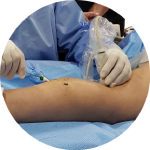
When a patient presents with edema the etiology can vary
Julian J. Javier, MD, FSCAI, FCCP, recently offered key differentiators with a talk on Leg Swelling: Venous, Lymphatic, Lipedema or Cardiac.
Dr. Javier began the session with the story of a patient: a 72-year-old woman who came to his office seeking a second opinion 18 months after bilateral iliac vein stents. She had been complaining of leg edema for the last six years and had noticed darkening of her skin. She also had undergone multiple abdominal and pelvic surgeries, and a complete venous ultrasound showed normal superficial and deep veins and patent stents.
Edema, also called leg swelling, is defined as the recognizable interstitial expansion of fluid in a limb due to multiple medical reasons, he said. Etiology can be circulatory or non-circulatory, ranging from venous disease, congestive heart failure, lymphedema and lipedema in the first category to renal failure, pregnancy, liver failure, medications and NSAIDS in the latter.
Lymphedema, Dr. Javier said, is "nothing more than the accumulation of protein-rich fluid in the interstitial tissue due to lymphatic drainage failure; it's an inherent defect within the lymph-carrying conduits." But it's also something that challenges more than 10 million Americans, and 250 million people across the globe. That's more than AIDS, multiple sclerosis, muscular dystrophy, Parkinson's disease and ALS combined.
And yet, medical students receive very little training on lymphedema; many physicians consider it a "minor event," though patients consider it important. Further, few physicians are aware of treatments available.
Three types of primary lymphedema have been recognized: congenital, present at birth or recognized within two years; preacox, occurring at puberty or by the beginning of the third decade of life; and tarda, beginning after the age of 35. Secondary lymphedema can be caused by a variety of factors. Those with lymphedema may present with symptoms such as hyperkeratosis, elephantiasis, orange skin or lymphostatic ulceration.
The good news is that those with lymphedema typically respond "very well" to compression therapy.
Dr. Javier then focused on edema from congestive heart failure. More than 12 million Americans have CHF, and the most common lower extremity complaints include leg swelling, leg heaviness and skin changes. Of the four classes of heart failure, edema is typically seen in Class II and Class III. He also touched on venous edema and noted that he "rarely" sees venous insufficiency patients that only have edema; other symptoms are usually present.
As for lipedema, Dr. Javier noted that only 9 percent of patients in a British study said that their healthcare provider diagnosed lipedema when symptoms were first reported. Because it bears clinical resemblance to obesity, he said, it is frequently misdiagnosed. "It seems to be related to hormonal shift and genetic predisposition," Dr. Javier said.
He offered a summary table of leg edema, noting the similarities and differences between venous, lipedema, lymphedema and heart failure. His final diagnosis of the patient was lymphedema.
Insightful sessions like this are available on demand with a subscription to Vein Global. You'll find tips, techniques and more from leaders in the venous disease treatment profession. Why not join us?
Recent Posts

Review of Radiofrequency Ablation Devices

Overtreatment in CVD Leads to Superficial Ablation Abuse

Ultrasound-guided Foam Sclerotherapy

Recurrent Stent Occlusion: Endovenectomy, Bypass, or Compression Only

Optimizing Deep Vein Images: The Profunda Femoris Vein

A Closer Look at Swollen Legs: Edema Differentiation

Vein Global and IVC are Evolving to Launch the Next Decade of Endovascular Innovation and Education

Phlebectomy: Technical Steps with Jose I. Almeida, MD, FACS, RPVI, RVT

The Spectrum of Vacuum-Assisted Venous Thrombectomy

Sclerotherapy: Technical Steps with Julian J. Javier, MD, FSCAI, FCCP

